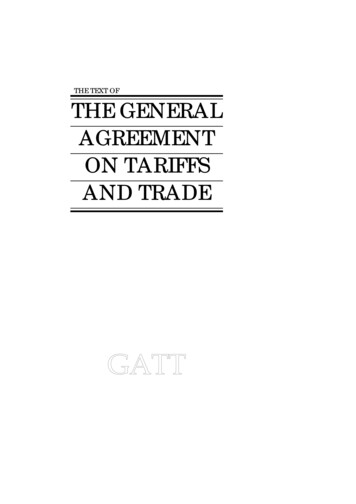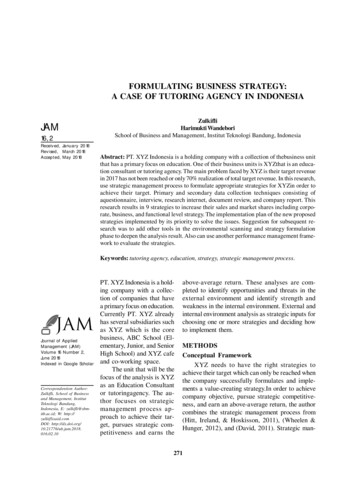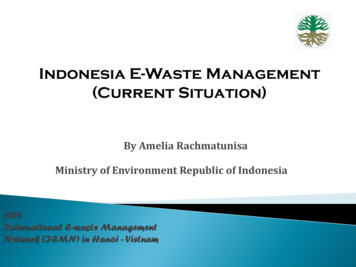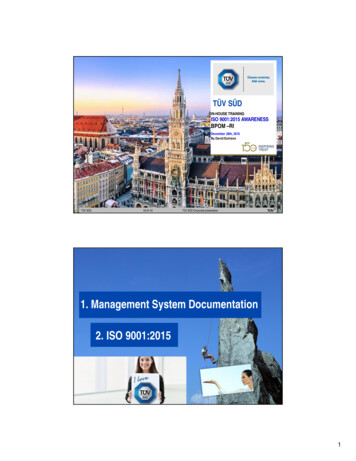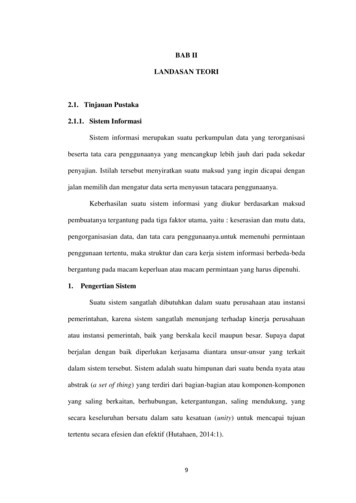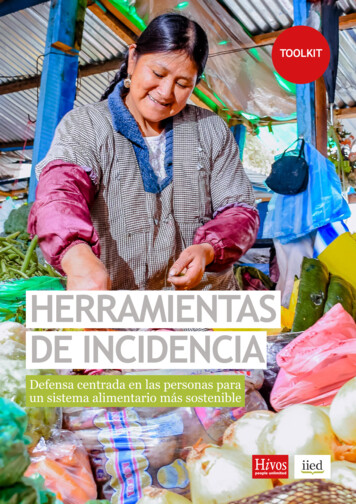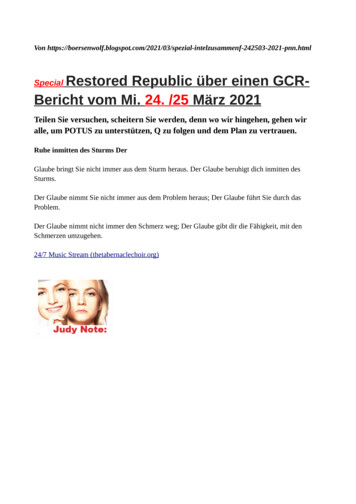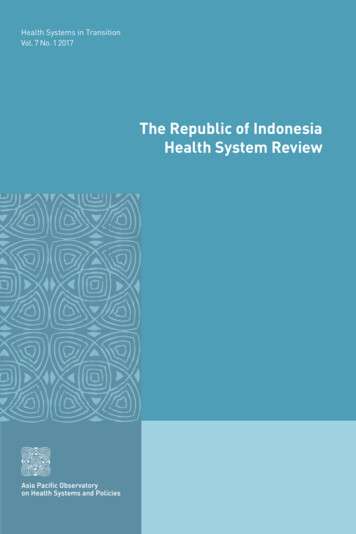
Transcription
Health Systems in TransitionVol. 7 No. 1 2017The Republic of IndonesiaHealth System Review
Health Systems in TransitionVol. 7 No. 1 2017The Republic of IndonesiaHealth System ReviewWritten by:Yodi Mahendradhata, Department of Public Health, Faculty of Medicine, Universitas Gadjah MadaLaksono Trisnantoro, Universitas Gadjah MadaShita Listyadewi, Center for Health Policy and Management, Universitas Gadjah MadaPrastuti Soewondo, School of Public Health, University of IndonesiaTiara Marthias, Center for Health Policy and Management, Universitas Gadjah MadaPandu Harimurti, World Bank JakartaJohn Prawira, Center for Health Policy and Management, Universitas Gadjah MadaEdited by:Krishna Hort, Nossal Institute for Global Health, University of MelbourneWalaiporn Patcharanarumol, International Health Policy Program, Ministry of Public Health ThailandAsia Pacific Observatory on Health Systems and Policiesi
WHO Library Cataloguing-in-Publication dataWorld Health Organization, Regional Office for South-East Asia.The Republic of Indonesia health system review.Health systems in transition. Vol-7, Number -11. Health Systems Plans. 2. Health Status. 3. Economics, Medical. 4. Health Care Reform. 5. PublicHealth. I. Indonesia.ISBN 978-92-9022-516-4(NLM classification: WA 540.1) World Health Organization 2017(on behalf of the Asia Pacific Observatory on Health Systems and Policies)All rights reserved.Requests for publications, or for permission to reproduce or translate WHO publications – whetherfor sale or for noncommercial distribution – can be obtained from SEARO Library, World HealthOrganization, Regional Office for South-East Asia, Indraprastha Estate, Mahatma Gandhi Marg, NewDelhi 110 002, India (fax: 91 11 23370197; e-mail: searolibrary@who.int).The designations employed and the presentation of the material in this publication do not imply theexpression of any opinion whatsoever on the part of the World Health Organization concerning thelegal status of any country, territory, city or area or of its authorities, or concerning the delimitation ofits frontiers or boundaries. Dotted lines on maps represent approximate border lines for which theremay not yet be full agreement.The mention of specific companies or of certain manufacturers’ products does not imply that theyare endorsed or recommended by the World Health Organization in preference to others of a similarnature that are not mentioned. Errors and omissions excepted, the names of proprietary products aredistinguished by initial capital letters.All reasonable precautions have been taken by the World Health Organization to verify the informationcontained in this publication. However, the published material is being distributed without warranty ofany kind, either expressed or implied. The responsibility for the interpretation and use of the materiallies with the reader. In no event shall the World Health Organization be liable for damages arisingfrom its use.The views expressed in this publication are those of the authors and may not necessarily representthe decisions or policies of the World Health Organization.Printed in Indiaii
ContentsPreface. ixAcknowledgements. xiList of abbreviations. xiiiAbstract. xxiiiExecutive summary.xxivChapter 1 Introduction. 1Chapter summary. 11.1 Geography and sociodemography. 11.2 Economic context. 51.3 Political context. 81.4 Health status.12Chapter 2 Organization and governance. 18Chapter summary.182.1 Overview of the health system.192.2 Historical background.212.3 Organization.242.4 Decentralization and centralization.282.5 Planning.302.6 Intersectorality.342.7 Health information management.372.8 Regulation.422.9 Patient empowerment.60Chapter 3 Health financing. 65Chapter summary.653.1 Health expenditure.663.2 Sources of revenue and financial flows.713.3 Overview of the public financing schemes.783.4 Out-of-pocket payments.923.5 Voluntary health insurance .943.6 Other financing.973.7 Payment mechanisms.98iii
Chapter 4 Physical and human resources. 106Chapter summary.1064.1 Physical resources.1074.2 Human resources.119Chapter 5 Provision of services. 132Chapter summary.1325.1 Public health.1345.2 Patient pathways.1505.3 Primary/ambulatory care.1515.4 Inpatient care.1565.5 Emergency care.1585.6 Pharmaceutical care.1605.7 Rehabilitation/intermediate care.1625.8 Long-term care.1645.9 Services for informal carers.1645.10 Palliative care.1645.11 Mental health care.1655.12 Dental care.1665.13 Complementary and alternative medicine (CAM)and traditional medicine.1685.14 Health services for specific populations.169Chapter 6 Principal health reforms. 170Chapter summary.1706.1 Analysis of recent reforms.1716.2 Future developments.200Chapter 7 Assessment of the health system. 212Chapter summary.2127.1 Stated objectives of the health system.2137.2 Financial protection and equity in financing.2177.3 User experience and equity of access to health care.2237.4. Health outcomes, health service outcomes and quality of care.2287.5. Health system efficiency.2347.6 Transparency and accountability.237Chapter 8 Conclusions. 2398.1 Key findings.2398.2 Lessons learnt from health system changes.2418.3 Remaining challenges.2428.4 Future prospects.244iv
Chapter 9 Appendices. 2459.1 References .2459.2 Further reading.2889.3 Useful web sites.2899.4 HiT methodology and production process .2899.5 About the authors.291List of FiguresFigure 1.1Figure 1.2Figure 1.3Figure 1.4Figure 2.1Figure 3.1Figure 3.2Figure 3.3Figure 3.4Figure 3.5Figure 3.6Figure 3.7Figure 3.8Figure 4.1Figure 4.2Population of Indonesia, 2010 (left) and projected for2030 (right).4Indonesia’s demographic dividend .5Selected governance indicators for Indonesia,percentile rank (1–100). 11Burden of disease attributable to 15 leading risk factorsin 2010, expressed as a percentage of Indonesian DALYs. 13Organization of health system in Indonesia, 2014. 21Health expenditure as a share (%) of GDP in the WHOSouth-East Asia and Western Pacific Regions, 2014. 68Trends in health expenditure as a share (%) of GDP inIndonesia and selected Asian countries, 1995–2014. 68Health expenditure in US PPP per capita in Indonesiaand countries in the WHO South-East Asia and WesternPacific Regions, 2014. 69Public sector health expenditure as a share (%) of THEin Indonesia and in countries in the WHOSouth-East Asia and Western Pacific Regions, 2019. 69Percentage of total expenditure on health accordingto source of revenue, 2014*. 73Financial flows, 2014. 75Flow of transfers to the local level and fund sourcesfor local government budget. 83Cooperation model between providers andBPJS Kesehatan. 91Mix of beds in acute and psychiatric hospitals(including inpatient puskesmas) in Indonesiaper 1000 population, 1990–2014. 113Bed occupancy rate and length of stay, Indonesia,2004–2012. 114v
Figure 4.3Average length of stay in Indonesia and selectedcountries, 2000–2011. 115Figure 4.4 Trends in the number of hospital beds per 1000population in Indonesia and selected countries,2000–2014. 115Figure 4.5 Ratio of physicians to 1000 population in Indonesiaand selected countries, 2000–2011. 121Figure 4.6 Number of nurses per 1000 population in Indonesiaand selected countries, 1990–2011. 123Figure 4.7 Nurse distribution and ratio to population. 124Figure 4.8 Midwife distribution and ratio to population. 125Figure 4.9 Number of dentistry personnel per 1000 populationin Indonesia and selected countries. 126Figure 4.10 Number of pharmaceutical personnel per 1000population in Indonesia and selected countries,2010 and 2011. 126Figure 5.1 Pathways of JKN and non-JKN patients. 151Figure 6.1 A continuum between bureaucratic institutionsand State-owned enterprises. 181Figure 7.1 Percentage of households experiencing catastrophiclevels of health expenditure by province of Indonesia. 219Figure 7.2 Patient satisfaction, normal delivery, nine hospitals(hospital average scores ranged from 34% to 43%). 224Figure 7.3 Median distance to nearest health facility by provinceof Indonesia, 2011. 226Figure 7.4 Time to reach nearest public hospital and puskesmasby province of Indonesia, 2013. 226Figure 7.5 Key population health outcomes in Indonesia,1970–2012. 228Figure 7.6 Neonatal mortality (per 1000 live births) by variouscharacteristics. 233Figure 7.7 Health expenditure by function (%), 2011. 235vi
List of TablesTable 1.1Table 1.2Table 1.3Table 1.4Table 1.5Table 1.6Table 1.7Table 1.8Table 3.1Table 3.2Table 3.3Table 3.4Table 3.5Table 3.6Table 3.7Table 3.7Table 3.8Table 3.9Table 3.10Table 3.11Table 3.12Table 3.13Table 4.1Trends in population/demographic indicators,selected years.3Macroeconomic indicators, selected years.6Mortality and health indicators, selected years. 12Main causes of Death (%). 14Major causes of DALYs lost. 15Morbidity of selected diseases, 2007–2011. 15Major risk factors affecting health status (DALYs),selected years. 15Maternal, child and adolescent health indicators,selected years. 16Trends in total health expenditure (THE) in Indonesia,1995–2014. 67Public health expenditure on health by serviceprogramme, 2014. 70Actual spending on health at various ministries andcentral government institutions, 2005, 2012 and 2014. 71Ministries, institutions and health programmes. 72Sources of revenue as a percentage of total expenditureon health according to source of revenue, 1995–2014. 73Plan for membership expansion. 79Differences in premiums and benefits for membershipclasses in JKN. 80Differences in premiums and benefits for membershipclasses in JKN (Con’t.). 81Premium contributions by non-PBI membersto the JKN scheme. 85JKN members, based on types of membership, 2014. 86Out-of-pocket (OOP) payments and population density. 93Number of people covered by VHI, 2008–2012. 95Number of entities selling private VHI offering healthbenefits in 2012. 96Provider payment mechanisms. 101Number of inpatient facilities and beds,by ownership and service class, 2014. 108vii
Table 4.2Table 4.3Table 4.4Table 4.5Table 4.6Table 4.7Table 4.8Table 5.1Table 5.2Table 5.3Table 6.1Table 7.1Table 7.2Table 7.3Table 7.4Table 7.5Table 7.6Table 7.7Table 7.8Number of beds in acute care hospitals, 1990–2014. 112Geographical distribution of hospitals in Indonesiaby region, 2012. 113Number of public sector primary care facilitiesin Indonesia, 2000–2014. 116Distribution of puskesmas by Region, Indonesia 2013. 116Number of functioning diagnostic imaging technologies(MRI units, CT scanners, PET scanners) per millionpopulation in Indonesia, 2013. 117Health workers in Indonesia per 1000 population,1990 to latest available year. 120Distribution of doctors in Indonesia by geographicalareas (2015). 122Puskesmas network and community-based care. 152Hospital classification. 157Summary of market characteristics of pharmaceuticals. 159Minimum basic services package. 178The Government of Indonesia’s health sector objectives,2010–2014. 216Kakwani indexes of public health-caresubsidy – Indonesia. 221Outpatient and inpatient utilization rates, 2004–2012. 227Quality of ANC services score based on vignetteresponses. 230Availability of key vaccines at private clinics. 231Quality of child curative services score basedon vignette responses. 231Quality of diabetes services score basedon vignette responses. 232Examples of policy documents on quality and safety. 232List of BoxesBox 2.1Box 6.1Box 7.1viiiFormal hierarchy of regulation 42Major reforms 170JKN case study in Ngada and Sumba Timur districts,East Nusa Tenggara Province 222
PrefaceThe Health Systems in Transition (HiT) profiles are country-based reportsthat provide a detailed description of a health system and of reformand policy initiatives in progress or under development in a specificcountry. Each profile is produced by country experts in collaboration withan international editor. To facilitate comparisons between countries,the profiles are based on a template, which is revised periodically. Thetemplate provides detailed guidelines and specific questions, definitionsand examples needed to compile a profile.A HiT seeks to provide relevant information to support policy-makers andanalysis in the development of health systems. This can be used: to learn in detail about different approaches to the organization,financing and delivery of health services and the role of the mainactors in health systems;to describe the institutional framework, process, content andimplementation of health-care reform programmes;to highlight challenges and areas that require more in-depthanalysis;to provide a tool for the dissemination of information on healthsystems and the exchange of experiences between policy-makersand analysts in different countries implementing reformstrategies; andto assist other researchers in more in-depth comparative healthpolicy analysis.Compiling the profiles poses a number of methodological problems.In many countries, there is relatively little information available on thehealth system and the impact of reforms. Due to the lack of a uniformdata source, quantitative data on health services is based on a numberof different sources, including the World Health Organization (WHO),national statistical offices, the Organisation for Economic Co-operationand Development (OECD) health data, the International Monetary Fund(IMF), the World Bank, and any other sources considered useful by theix
authors. Data collection methods and definitions sometimes vary, buttypically are consistent within each separate series.The HiT profiles can be used to inform policy-makers about theexperiences in other countries that may be relevant to their own nationalsituation. They can also be used to inform comparative analyses of healthsystems. This series is an ongoing initiative, and material will be updatedat regular intervals.Comments and suggestions for the further development andimprovement of the HiT series are most welcome and can be sentto apobservatory@who.int. HiT profiles and HiT summaries forcountries in Asia Pacific are available on the Observatory’s website athttp://www.wpro.who.int/asia pacific observatory/en/.x
AcknowledgementsThe writing team wishes to express thanks particularly to colleaguesin the Ministry of Health, Republic of Indonesia (Nafsiah Mboy,Ali Ghufron Mukti, Jane Soepardi, Vensya Sitohang, HarimatHendarwan, Widiati, Eka Nugrahi, Agus Purwadianto, Nana Suryana,Trihono, Rudy Kurniawan, Amnur, Soewarta Kosen), who providedinformation and invaluable comments on previous drafts of theIndonesia HiT manuscript. The team also benefited much frominput provided by colleagues at the National Planning Bureau(Pungkas Bahjuri Ali), the World Bank (Darren Dorkin, Eko Pambudi),AusAID/DFAT (Debbie Muirhead, Danielle Sever, Adrian Gilbert),GIZ (Harmein Harun, Stephanus Indradjaya), UNFPA (Jose Ferraris,Melania Hidayat), WHO (Eijiro Murakoshi), RTI International(Jeffery J. Sine) and the University of Indonesia (Hasbullah Thabrani).Additional input was provided by colleagues at Universitas GadjahMada (M. Faozi Kurniawan, Deni Harbianto, Andreasta Meliala,Putu Eka Andayani, Dwi Handono, Trisasi Lestari, Citra DewiFitri Astuti, Likke Prawidya Putri, Sri Suryawati, Erna Kristin,Carla Machira and Lisdrianto Hanindriyo). The writing team wassupported by research assistants based at Universitas Gadjah Mada(Nandyan Nurlaksana, Winda Puspita, Dhini Rahayu Ningrum,Deni Harbianto, Intan Farida Yasmin) and the University of Indonesia(Kurnia Sari, Yunita). Without the support and facilitation of all thecontributors mentioned above, this profile could not have beencompleted.The team is grateful to the HiT editor Dr Krishna Hort (NossalInstitute for Global Health, University of Melbourne) and Dr WalaipornPatcharanarumol (International Health Policy Program, Ministryof Public Health Thailand). The team also thanks the Asia PacificObservatory on Health Systems and Policies (APO) Secretariat – inparticular, Dr Dale Huntington, Dr Nima Asgari and Dr Mikiko Kanda– for providing technical input and continuous support throughoutthe project. The contributions by colleagues at the Institute forHealth Policy, Sri Lanka – Ravindra Rannan-Eliya and RuwaniWickramasinghe – to earlier drafts of the Indonesia HiT are alsoacknowledged.xi
Peer reviewers on behalf of the Asia Pacific Observatory on HealthSystems and Policies:The Indonesia HiT was peer reviewed by Dr John Langenbrunner (Billand Melinda Gates Foundation) and Dr Alejandro Herrin (University ofPhilippines).xii
List of abbreviationsACTArtemisinin combination therapyAFASASEAN Framework Agreement on ServicesAIAvian influenzaAJCCDASEAN Joint Coordinating Committee on DentistryAJCCMASEAN Joint Coordinating Committee on MedicineAJCCNASEAN Joint Coordinating Committee on NursingALOSAverage length of stayAMDALAnalisis mengenai dampak lingkungan (environmentalimpact assessment)ANCAntenatal careAPBDAnggaran dan pendapatan belanja daerah (Local Revenueand Expenditure Budget)APBNAnggaran Pendapatan dan Belanja Nasional (nationalbudget)APEKSIAsosiasi Pemerintah Kota Seluruh Indonesia (Associationof Indonesian Municipal Governments)APKASIAsosiasi Pemerintah Kabupaten Seluruh Indonesia(Association of Indonesian District Governments)ARSADAAsosiasi Rumah Sakit Daerah (Local governmenthospitals association)ARSANIAsosiasi Rumah Sakit Nirlaba Indonesia (not-for-profithospitals association)ARSPIAsosiasi Rumah Sakit Pendidikan Indonesia (teachinghospitals association)ARSSIAsosiasi Rumah Sakit Swasta Indonesia (private hospitalsassociation)ARSVIAsosiasi Rumah Sakit Vertikal Indonesia (association ofcentral government hospitals)AsabriAsuransi Angkatan Bersenjata Republik Indonesia (ArmedForces Social Insurance Company)AskesAsuransi kesehatan (health insurance)xiii
AskeskinAsuransi Kesehatan Masyarakat Miskin (a targeted socialhealth insurance scheme for the poor)ASPAKIAsosiasi Produsen Alat Kesehatan Indonesia (Associationof Health Equipment Manufacturers)AstekAsuransi Tenaga Kerja (worker insurance)AusAIDAustralian Agency for International DevelopmentBalitbangkesBadan Penelitian dan Pengembangan Kesehatan (NationalInstitute for Health Research and Development)BAN-PTBadan Akreditasi Nasional – Perguruan Tinggi (HigherEducation National Accreditation Bureau)BAPEDALEnvironmental Impact Management AgencyBappedaBadan Perencanaan Pembangunan Daerah (localdevelopment planning agency)BappenasBadan Perencanaan Pembangunan Nasional (Ministry ofNational Development Planning)BawasdaBadan Pengawasan Daerah (regional audit agency)BDBidan Delima (Midwives Delima)BKKBNBadan Kependudukan dan Keluarga Berencana Nasional(National Population and Family Planning Board)BKPMBadan Koordinasi Penanaman Modal (IndonesianInvestment Coordinating Board)BLUBadan Layanan Umum (Public Service Agency)BLUDBadan Layanan Umum Daerah (Local Public ServiceAgency)BNNBadan Narkotika Nasional (National Narcotics Agency)BNPBBadan Nasional Penanggulangan Bencana (IndonesianNational Board for Disaster Management)BNP2TKIBadan Nasional Penempatan dan Perlindungan TenagaKerja Indonesia (National Agency for Safety andPlacement of Indonesian Workforce)BOPTNBantuan Operasional Perguruan Tinggi NegeriBOSBoard of SupervisorsBOTBoard of TrusteesBPBDBadan Penanggulangan Bencana Daerah (RegionalDisaster Management Agency)BPJSBadan Pelaksana Jaminan Sosial (Social Security Agency)xiv
BPJS-KBadan Pelaksana Jaminan Sosial Kesehatan (SocialSecurity Agency for Health)BPKBadan Pemeriksa Keuangan (Supreme Audit Agency)BPKPBadan Pengawas Keuangan dan Pembangunan (Financialand Development Audit Agency)BPLHDBadan Pengelolaan Lingkungan Hidup Daerah (Localenvironmental management body)BPOMBadan Pengawasan Obat dan Makanan (Drug and FoodControl Agency)BPRSIBadan Pengawas Rumah Sakit Indonesia (Monitoring andSupervision Bureau for Hospitals)BPRSPBadan Pengawas Rumah Sakit Provinsi (Provincial Bureaufor Supervision of Hospitals)BPSBadan Pusat Statistik (Central Bureau of Statistics)BSMBantuan Siswa Miskin (Assistance for Poor Students)BTKLPPBalai Besar Teknis Kesehatan Lingkungan PemberantasanPenyakit (Technical Environmental Health and DiseaseEradication Body)BUKBina Upaya Kesehatan (Directorate of Health Services)BUMDBadan Usaha Milik Daerah (local government-ownedenterprises)BUMNBadan Usaha Milik Negara (state-owned enterprises)CAMComplementary and alternative medicineCBOCommunity-based organizationCBRCommunity-based rehabilitationCBTComputer-based testCDOBCara distribusi obat yang baik (good distribution practice)CDRCause of death registerCFSCertificate of Free SalesCPNSCalon Pegawai Negeri Sipil (civil servant candidates)CPRContraceptive prevalence rateCSOsCivil society organizationsDAKDana alokasi khusus (special allocation funds)DALYsDisability adjusted life yearsDAUDana alokasi umum (general allocation fund)DHODistrict health officexv
DJSNDewan Jaminan Sosial Nasional (National Social SecurityBoard)DNPIDewan Nasional Perubahan Iklim (Climate ChangeNational Council)DOTSDirectly observed treatment, short courseDOENDaftar obat esensial nasional (national essential drugslist)DPDDewan Perwakilan Daerah (Regional Council)DPRDewan Perwakilan Rakyat (House of Representatives)DPRDDewan Perwakilan Rakyat Daerah (local parliament)DSPDaftar susunan pegawai (list of positions)EASEmergency ambulance servicesEMTsEmergency medical techniciansEREmergency responseEWARSEarly warning alert and response systemFBOFaith-based organizationFKPKMIForum Kerjasama Pengembangan Kesehatan MasyarakatIndonesia (Collaboration Forum for IndonesianCommunity Health Development)FSCAField safety corrective actionGakeslabGabungan Perusahaan Alat Kesehatan dan Laboratorium(Associ
ISBN-13 978 92 9022 516 4. i The Republic of Indonesia Health System Review Health Systems in Transition Vol. 7 No. 1 2017 Written by: Yodi Mahendradhata, Department of Public Health, Faculty of Medicine, Universitas
